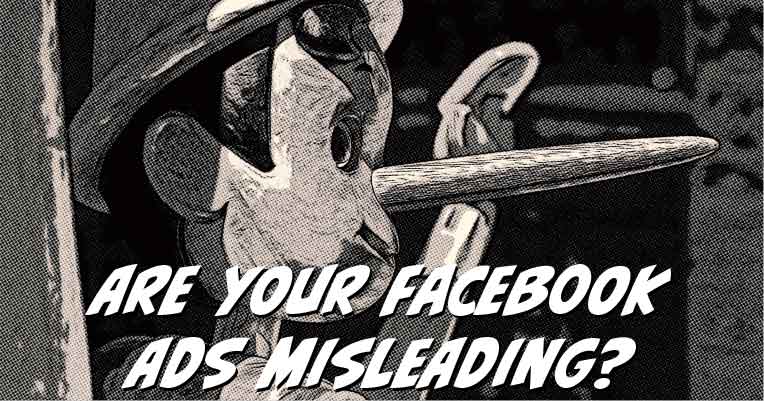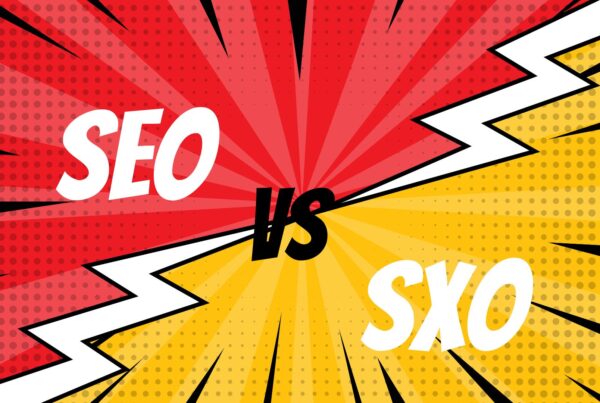Have you ever looked at an ad and felt the extreme urge to roll your eyes? While you might not consider a little clickbait as particularly misleading, and your ad passes the virtual blockade that is Facebook’s ad guidelines, you could still be creating ads that fail to reflect the reality of your offer because you got caught up in the attempt of making your ad clickable.
We mean no disrespect in presenting the following, but as responsible communicators, we must still say, avoid:
- False or exaggerated claims about a product or service.
- Omission of important information that could impact the consumer’s decision.
- Unrealistic or deceptive pricing information.
- Falsely implying endorsements or partnerships that do not exist.
- Misleading visuals that misrepresent the actual product or its features.
- Concealing or downplaying potential risks or side effects of a product.
- Manipulating statistics or data to present a false narrative.
- Using bait-and-switch tactics, promising one thing in the ad but delivering something different.
- Falsely implying exclusive or limited-time offers.
- Inventing testimonials or reviews.
- Deceptive comparison to competitors’ products or services.
- Misrepresenting the benefits or outcomes of using a product or service.
- Using ambiguous or confusing language that misdirects the consumer about the nature of the offer or product.
How to Avoid Overpromising in Your Ads

From its “Unrealistic Outcomes” policy to its “Unacceptable Business Practices” and “Misinformation” policies, Facebook’s Transparent Center (the “hub” where all of Facebook’s ad policies live) is an intimidating laundry-list of what not to do.
There are many solid resources on Facebook Guidelines and Best Practices, but we’ll cover the most important ones so that you can get your content seen without it getting flagged.
Based on a combination of Facebook’s guidelines, best practices, and what the vast majority of branding agencies follow, your ad should not:
- Read overly “salesy” or make outrageous claims (“Win $10,000 in a day!” or “Watch your sales skyrocket overnight!” or “Get to star in a film with Johnny Depp”)
- Insult or make negative assumptions about the end user; “Are you fat?”, “Do you wear a hijab?” “Have you struggled with homelessness?”
- Read as blatantly deceptive or false in its claims or business practices.
- Promote violence
- Defame a third-party entity or cooperation.
- Have false “play” buttons.
- Have poor grammar and punctuation.
In some cases, ads containing similar content can even lead to a permanent ban on your ad account. Don’t become a cautionary tale.
How to Make Promises You CAN Keep
- Write accurate ad copy.
- Be deliberate in your word choices when you describe the problem that is solved by your product or service.
- Prompt a free AI tool like Copy.ai to create descriptions of your product or service, then edit them for clarity and accuracy. The free plan lets you generate up to 2,000 words.
- Promote Easy Wins.
- Here, we’re talking about results you can guarantee in your sleep, even if it’s something small.
- Example: You can offer early access deals, free trials or consultations, discount codes or coupons, or even something as simple as personalized recommendations based on user preferences and needs pertaining to your product or service.
- Use Social Proof.
- Incorporate social proof elements such as testimonials, reviews, or case studies in your ads.
- Example: Customers trust customers, not corporations. Customer reviews and user-generated content are by far the best form of social proof.
- Not sure how to get reviews? Some companies incentivize their customers to share their product unboxing videos on social media in return for a feature on the page. You can also use AI to generate creative ideas on how to solicit reviews from your customers. These strategies work wonders to boost your brand’s credibility and give you tons of ammunition for your ads.
Quick Fix: Use Pictures of Happy People and Avoid Soulless Product Shots
You’re probably tired of hearing about content, but we live in the age of “Content Shock,” a term coined by Mark Shaefer to describe the extent to which we are all overwhelmed by the torrent of content we face every day.
So, when everyone you know is being hosed in the face with this surge of content, the best way to make your ads stand out is to create content that blends into their feed while containing all the elements they want to see.
If your ads look like ads, users will outright ignore them or block them. In fact, ad-blocking software is used by 30% of Internet users. This means more than a quarter of paid advertising messages will never reach their audiences. If you want to get your brand out there, you’re going to need stuff that kicks the competition’s content out of the ring.
What Makes an Ad Look Like an Ad?

Soulless product shots are static images of a product presented without any emotional context or human element. These shots focus solely on the physical attributes of the product, lacking the emotional appeal and relatability that can engage viewers on a deeper level. Unlike images featuring happy people using or interacting with the product, soulless product shots fail to evoke emotions, tell a story, or create a personal connection. They often lack the vitality and authenticity that human presence brings to an advertisement. As a result, these shots can feel uninspiring, detached, and distant, potentially leading to lower engagement, reduced brand connection, and decreased effectiveness in capturing viewers’ attention and driving conversions.
What Makes an Ad Blend in and Contain Elements People Want to See?
Happy people provide evidence of someone actively engaging with your product or service and boost your credibility. It allows the prospect to live vicariously through your imagery and see a future version of themselves with the product or service.
Ambitious business owners, with their minds on the grind and the Last Supper’s worth of work on their plates, will often have agencies run their ads and expect them to “invent” content because they’re busy, too inexperienced, or simply out of their depth. And while their digital marketing team is out hunting unicorns, their competitors have already swooped in.
Let’s put it this way: would you rather read a story about a cup of coffee or the person drinking said cup of coffee? You could try and go out of your way to personify your cup of coffee: give it a personality and a funky name, and write about its significance in culture. But at the end of the day, it’s just a cup of coffee. Meanwhile, tons of questions about the person drinking it come to mind: do they need the coffee, or is it just a hot beverage they enjoy? What is their body language as they drink it? Do they like their coffee black or with milk and sugar, and what does their preferred taste say about them? You now have a better angle because there is a person in the picture.
Your ads tell a story. Most people are going to want to read a story about other people rather than a story about an inanimate object. While there are no hard-and-fast rules, and there are certainly cases where you should make exceptions (i.e., shopping ads or product catalog ads), you’re more likely to see higher engagement on ads that stir up human emotion.
Such as:
Smiling Faces

Do you ever scroll through your news feed and feel the need to put your phone down two minutes in? Instead of using “click-me” photos deliberately depicting hardship, pain, or disaster, a good ad will use pictures of happy people. This is why most stock photos convey some emotion on the spectrum between excited and downright blissful. How many times have you browsed the web for a stock photo only to be slammed with “conventionally attractive man grinning intensely into a television screen” or “a group of laughing employees in tacky blazers holding hands like a cheerleading squad.”
You can picture it, right?
Jokes aside, while some brands do bank on shock value, including plenty of “reputable” business sites, it’s the honest marketer’s hat trick to hone in on the positive, which, lucky for us, drives more engagement.
“Native” Imagery

At BestLyfe Group, we encourage our clients to use pictures (and ad copy) that look and “feel” like just another social media post you’d come across on a friend’s feed. This keeps the “I’m being sold to!” alarm bells from going off in your prospect’s head while creatively showcasing what your brand has to offer.
Bad Example: Unbeatable deals! Limited time offer! Buy a Watch Now and Save Big!
You’re flying at your prospect with your arms flung out in hopes they’ll meet you halfway, but they don’t know who the hell you are, and you look like a grinning creep closing in for a hug they don’t want to give you.
Good Example: Searching for A Bargain? Save 60% on Resold Watches – Shipped Directly To Your Door.
Direct, to the point, and a front-loaded offer, followed up with clear benefits for online shoppers.
Sincere Clickbait

It may sound like an oxymoron, but using clickbait is beneficial. This ties into the idea of using numbers in your ad headlines or opening an ad with “power words” that draw emotion from the reader.
The point of sincere clickbait is to intentionally highlight an amazing promise (the clickbait portion of your message) and follow through on that promise by any means necessary (the impending benefit of acting on the message).
For example, imagine a business coach who wants to promote a public speaking workshop. The title could read:
7 Creative Ways To Keep People on Your Website Longer
This could be an advertisement selling your ad optimization services, but if you actually list these seven meaningful factors in the body of your ad, you’ll have followed through. Not only does this boost your credibility as a business, but you’re already working your magic on your prospect’s brain and proving yourself a trustworthy brand because the reader got what they came for.
It’s a no-brainer that ads with people in them perform better. However, depending on the industry you’re in, you can always split-test it with a product shot and see which one comes out the winner.
At the end of the day, effective advertising is as much about honesty as it is about creativity. Navigating digital marketing requires a careful balance between finding ways to engage your prospects while accurately reflecting your offer. Focus on truthful ad copy, showcase easy wins, and use social proof to create relatable narratives.





